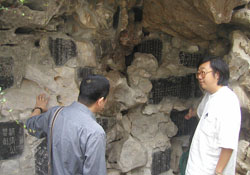Present occasion and history
 | |
| YE Fang in his garden Showing collected fragments of old inscriptions Suzhou, 2004 |
European art oscillates between these two perspectives, bringing them together in the 'white box' format of modern museums and galleries. In these surrogate holy places viewers 'come to the work,' and are encouraged to reflect on a state of truth. Art is endowed with transformative authority.
By contrast, Chinese literati art is resolutely secular in its modes of appreciation and has no imperative progressing towards perfection. Literati art criticism is more in the nature of a conversation, and appreciation encourages and records participation in performances where admirable effects are the consequence of great timing, apt company and circumstances. Seen this way, literati art is less a fixed thing than a situation, the viewer simultaneously subject and participant.
For literati, the past was 'another place' or 'other people' – at once distant from the present and yet offering fascinating and challenging parallels. A history of art was more like other histories that follow events, and concern for it was akin to the modern study of literature or ethnography. The past was also seen at different scales, ranging from grand narratives of states and kings, to records of moments in the lives of sensitive individuals who left their traces in texts, calligraphy or other forms.
Appreciating the past was both a matter for rigorous research and analysis, as well as a field for creative interpretation and a prod to creative practice. Looking forward in time, one foresaw oneself alongside figures from history.
- Page 1
- 2




